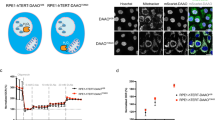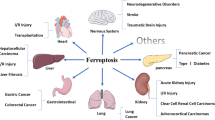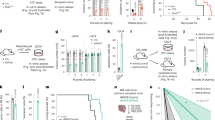Abstract
Aim:
To investigate the effect of diallyl disulfide (DADS), a component of garlic, on apoptosis in human mammary cancer cell line (MCF-7) and its mechanisms.
Methods:
Cytotoxicity was analyzed by 3-(4,5-dimethylthiazol-2-yl)-2,5-diphenyltetrazolium bromide assays. Morphology of apoptotic cells was detected by acridine orange and ethidium bromide staining. Apoptotic cells stained with propidium iodide were examined using flow cytometry. Protein levels were detected by Western blot analysis.
Results:
DADS inhibited the proliferation of MCF-7 cells and induced the apoptotic ratio to increase rapidly. Cleavage of the caspase-3 and caspase-3 substrate poly(ADP-ribose) polymerase was observed in MCF-7 cells after 24 h of treatment with DADS. When the MCF-7 cells were treated with 200 μmol·DL−1 DADS, the stress-activated protein kinase extracellular signal-regulated kinase (ERK), a mitogen-activated protein kinase, was inhibited after 6 h; c-Jun N-terminal kinase (JNK), that is stress-activated protein kinase (SAPK), and p38 mitogen-activated protein kinase were activated after 6 h.
Conclusion:
These results suggest that DADS both inhibits the proliferation of MCF-7 cells and induces apoptosis of MCF-7 cells. The mechanisms may include the inhibition of ERK and the activation of the SAPK/JNK and p38 pathways.
Similar content being viewed by others
Article PDF
References
Baselga J, Mendelsohn J . The epidermal growth factor receptor as a target for therapy in breast carcinoma. Breast Cancer Res Treat 1994; 29: 127–38.
Bange J, Zwick E, Ullrich A . Molecular targets for breast cancer therapy and prevention. Nat Med 2001; 7: 548–52.
Chopin V, Toillon RA, Jouy N, Bourhis X . P21 (WAF1/CIP1) is dispensable for G1 arrest, but indispensable for apoptosis induced by sodium butyrate in MCF-7 breast cancer cells. Oncogene 2004; 23: 21–9.
Agarwal KC . Therapeutic actions of garlic constituents. Med Res Rev 1996; 16: 111–24.
Sundaram SG, Milner JA . Diallyl disulfide induces apoptosis of human colon tumor cells. Carcinogenesis 1996; 17: 669–763.
Sundaram SG, Milner JA . Diallyl disulfide suppresses the growth of human colon tumor cell xenografts in athymic nude mice. J Nutr 1996; 126: 1355–61.
Singh SV, Mohan RR, Agarwal R, Benson PJ, Hu X, Rudy MA, et al. Novel anti-carcinogenic activity of an organosulfide from garlic: inhibition of H-RAS oncogene transformed tumor growth in vivo by diallyl disulfide is associated with inhibition of p21H-ras processing. Biochem Biophys Res Commun 1996; 225: 660–5.
Knowles LM, Milner JA . Possible mechanism by which allyl sulfides suppress neoplastic cell proliferation. J Nutr 2001; 131: 1061–6.
Druesne N, Pagniez A, Mayeur C . Diallyl disulfide (DADS) increases histone acetylation and p21waf1/cip1 expression in human colon tumor cell lines. Carcinogenesis 2004; 25: 1227–36.
Hong YS, Ham YA, Choi JH, Kim J . Effects of allyl sulfur compounds and extract on the expression of Bc1–2, Bax and p53 in non small cell lung cancer cell lines. Exp Mol Med 2000; 32: 127–34.
Yuan JP, Wang GH, Ling H, Su Q, Yang YH, Song Y, et al. Diallyl disulfide-induced G2/M arrest of human gastric cancer MGC803 cells involves activation of p38 MAP kinase pathways. World J Gastroenterol 2004; 10: 2731–4.
Hetman M, Xia Z . Signaling pathways mediating anti-apoptotic action of neurotrophins. Acta Neurobiol Exp 2000; 60: 531–45.
Davis R J . Signal transduction by the JNK group of MAP kinases. Cell 2000; 103: 239–52.
Kohno M, Pouyssegur J . Pharmacological inhibitors of the ERK signaling pathway: application as anticancer drugs. Prog Cell Cycle Res 2003; 5: 219–24.
Niemann-Jönsson A, Ares MP, Yan ZQ, Bu DX, Fredrikson GN, Brånén L, et al. Increased rate of apoptosis in intimal arterial smooth muscle cells through endogenous activation of TNF receptors. Arterioscler Thromb Vasc Biol 2001; 21: 1909–14.
Liu ZZ, Chen JP, Zhao SL, Li CL . Apoptosis-inducing effect of alternol on mouse lymphocyte leukemia cells and its mechanism. Yao Xue Xue Bao 2007; 42: 1259–65.
Pang JJ, Xu RK, Xu XB, Cao JM, Ni C, Zhu WL, et al. Hexarelin protects rat cardiomyocytes from angiotensin II-induced apoptosis in vitro. Am J Physiol Heart Circ Physiol 2004; 286: 1063–9.
Nakagawa H, Tsuta K, Kiuchi K, Senzaki H, Tanaka K, Hioki K, et al. Growth inhibitory effects of diallyl disulfide on human breast cancer cell lines. Carcinogenesis 2001; 22: 891–7.
Zhou ZX, Sun XH, Kang YJ . Ethanol-induced apoptosis in mouse liver Fas- and cytochrome c-mediated caspase-3 activation pathway. Am J Pathol 2001; 159: 329–38.
Terutoshi H, Saeko TO, Kaoru T, Yasuo M, Toshio N, Yumi T, et al. Caspase-3 activation by lysosomal enzymes in cytochrome c-inde-pendent apoptosis in myelodysplastic syndrome-derived cell line P39. Cancer Res 2001; 61: 2878–84.
Kwon KB, Yoo SJ, Ryu DG . Induction of apoptosis by diallyl disulfide through activation of caspase-3 in human leukemia HL-60. Biochem Pharmacol 2002; 63: 41–7.
Gunadharini DN, Arunkumar A, Krishnamoorthy G . Antiproliferative effect of diallyl disulfide (DADS) on prostate cancer cell line LNCaP. Cell Biochem Funct 2006; 24: 407–12.
Chang L, Karin M . Mammalian MAP kinase signalling cascades. Nature 2001; 410: 37–40.
Ling H, Zhang LY, Su Q . Erk is involved in the differentiation induced by diallyl disulfide in the human gastric cancer cell line MGC803. Cell Mol Biol Lett 2006; 11: 408–23.
Yuan JP, Wang GH, Ling H . Diallyl disulfide-induced G2/M arrest of human gastric cancer MGC803 cells involves activation of p38 MAP kinase pathways. World J Gastroenterol 2004; 10: 2731–4.
Kolbus A, Herr I, Schreiber M . c-Jun-dependent CD95-L expression is a rate-limiting step in the induction of apoptosis by alkylating agents. Mol Cell Biol 2000; 20: 575–82.
Hatai T, Matsuzawa A, Inoshita S . Execution of apoptosis signal-regulating kinase I (ASKI)-induced apoptosis by the mitochondria-dependent caspase activation. J Biol Chem 2002; 75: 26 576–81.
Holloway G, Coulson BS . Rotavirus activates JNK and p3 8 signaling pathways in intestinal cells, leading to AP-1-driven transcriptional responses and enhanced virus replication. J Virol 2006; 11: 10 624–33.
Li XH, Zhang R, Luo DH, Park SJ, Wang Q, Yongsok K, et al. Tumor necrosis factor α-induced desumoylation and cytoplasmic trans-location of homeodomain-interacting protein kinase 1 are critical for apoptosis signal-regulating kinase 1-JNK/p38 activation. J Biol Chem 2005; 15: 15 061–70.
Hargett D, McLean T, Bachenheimer SL . Herpes simplex virus ICP27 activation of stress kinases JNK and p38. J Virol 2005; 13: 8348–60.
Author information
Authors and Affiliations
Corresponding author
Additional information
Project supported by National Natural Science Foundation of China (No 30300426).
Rights and permissions
About this article
Cite this article
Lei, Xy., Yao, Sq., Zu, Xy. et al. Apoptosis induced by diallyl disulfide in human breast cancer cell line MCF-7. Acta Pharmacol Sin 29, 1233–1239 (2008). https://doi.org/10.1111/j.1745-7254.2008.00851.x
Received:
Accepted:
Issue Date:
DOI: https://doi.org/10.1111/j.1745-7254.2008.00851.x
Keywords
This article is cited by
-
The potential role of hydrogen sulfide in cancer cell apoptosis
Cell Death Discovery (2024)
-
Histone Modifying Potential of Dietary Phytochemicals: Implications in Treating Breast Cancer
Current Pharmacology Reports (2023)
-
Design, Fabrication and Evaluation of Stabilized Polymeric mixed micelles for Effective Management in Cancer Therapy
Pharmaceutical Research (2022)
-
Redox Modulation at Work: Natural Phytoprotective Polysulfanes From Alliums Based on Redox-Active Sulfur
Current Pharmacology Reports (2018)
-
Prophylaxis of Diallyl Disulfide on Skin Carcinogenic Model via p21-dependent Nrf2 stabilization
Scientific Reports (2016)



